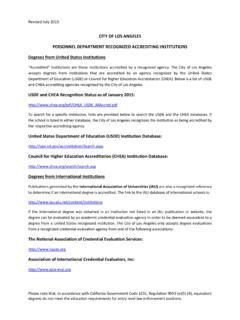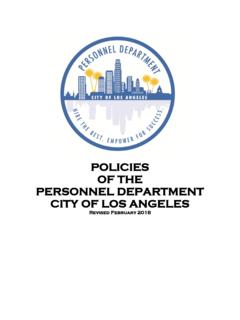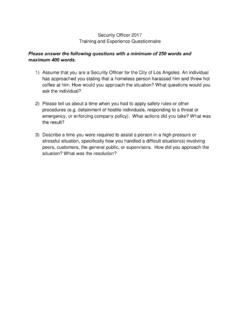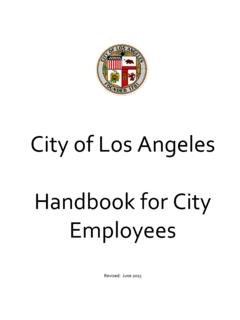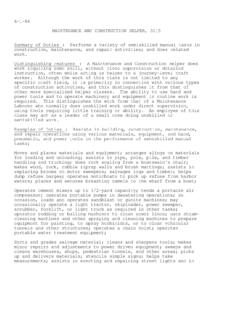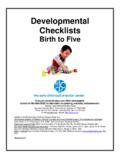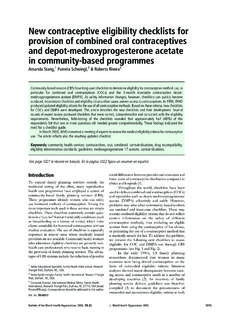Transcription of SAFETY INSPECTION CHECKLISTS - Los Angeles
1 SAFETY INSPECTION CHECKLISTS City of Los Angeles DEPARTMENT NAME FORWARD SELF- INSPECTION . The most widely accepted way to identify hazards in the workplace is to conduct SAFETY and health self-inspections. You can only be certain that actual situations exist in the workplace if you check them from time to time. Begin a program of self- INSPECTION in your workplace. Self- INSPECTION is necessary if you are to know where probable hazards exist and whether they are under control. This document contains twenty-two SAFETY INSPECTION CHECKLISTS designed to help you evaluate your work areas.
2 They will give you some indication of where you should begin action to make your workplace safer and more healthful for your employees. These CHECKLISTS are not all inclusive. You may wish to add to them or delete portions that do not apply to your workplace. Consider carefully each item as you come to it and then make your decision. Do not spend time with items that have no application to your workplace. Make sure you check each item on the list and leave nothing to memory or chance. Write down what you see (or do not see) and what you think should be done about it. YOU MUST COMPLY WITH THE CALIFORNIA OCCUPATIONAL SAFETY AND HEALTH LAW (CAL-OSHA STANDARDS) FOR MANY OF THE TOPICS COVERED IN THESE CHECKLISTS .
3 When you have completed the CHECKLISTS , you will have enough information to decide if problems exist. Once you have identified hazards, you can begin corrective actions and control procedures. SCOPE. The scope of self-inspections should cover the following areas: Processing, Receiving, Shipping and Storage. Equipment, job planning, layout, heights, floor loads, materials handling and storage methods. Building and Grounds. Floors, walls, ceilings, exits, stairs, walkways, ramps, platforms, driveways and aisles. Housekeeping Program. Waste disposal, tools, objects, materials, leakage and spillage, cleaning methods, schedules, work areas, remote areas and storage areas.
4 Electrical. Equipment, switches, breakers, fuses, switch boxes, junctions, special fixtures, circuits, insulation, extension cords, tools, motors, grounding, compliance with codes. Lighting. Type, intensity, controls, conditions, diffusion, location, glare and shadow control. Heating and Ventilation. Type, effectiveness, temperature, humidity, controls, natural and artificial ventilation and exhausting. Machinery. Points of operation, flywheels, gears, shafts, pulleys, key ways, belts, couplings, sprockets, chains frames, controls, lighting for tools and equipment, brakes, exhausting, feeding, oiling, adjusting, maintenance, lockout, grounding, work space, location and purchasing standards.
5 FORWARD CONTINUED Personnel. Training, experience, methods of checking machines before use, clothing, personnel protective equipment, use of guards, tool storage, work practices, method of cleaning, oiling or adjusting machinery. Hand and Power Tools. Purchasing standards, INSPECTION , storage, repair, types, maintenance, grounding, use and handling. Chemicals. Storage, handling, transportation, spills, disposal, amounts used, toxicity or other harmful effects, warning signs, supervision, material SAFETY data sheets, supervision, training, personal protective equipment and clothing.
6 Fire Prevention. Extinguishers, alarms, sprinklers, smoking rules, exits, personnel assignments, separation of flammable materials and dangerous operations, explosive proof fixtures in hazardous locations and waste disposal. Maintenance. Regularity, effectiveness, training of personnel, materials and equipment used, records maintained, method of locking out machinery and general methods. Personal Protective Equipment. Type, size, maintenance, repair, storage, assignment of responsibility, purchasing methods, standards observed, training in care and use, rules of use and method of assignment.
7 SAFETY INSPECTION checklist NO. 1 GENERAL WORK ENVIRONMENT Department/Division: _____ Date Of INSPECTION : _____ Location: _____ Inspector: _____ Criteria YesNoN/AAre work areas properly illuminated? Is the ventilation system appropriated for the work performed? Are restrooms and washrooms kept clean and sanitary? Is potable water provided for drinking and washing? Are outlets for water not suitable for drinking clearly identified? Where heat stress is a problem, do all fixed work areas have air conditioning? Is the work area clean and orderly? Are floors kept clean and dry or have you taken appropriate measures to make floors slip resistant?
8 Are floors free from protruding nails, splinters, holes, Are permanent aisles and passageways clearly marked? Are aisles and passageways kept clear? Are pits and floor openings covered or guarded? Is combustible trash removed from the worksite daily? Are spilled materials or liquids cleaned up immediately? Is there safe clearance in aisles where motorized or mechanical handling equipment travel? FLOOR AND WALL OPENINGS, STAIRS AND STAIRWAYS Are floor openings guarded by covers or guardrails on all sides? Do skylights have screens or fixed railings that would prevent someone on the roof from falling through?
9 Are open pits and trap doors guarded? Are grates or similar type covers over floor openings such as floor drains, designed so that foot traffic or rolling equipment are not affected by grate spacing? Are open-sided floors, platforms and runways having a drop of more than 4 feet guarded by a standard railing or toe board? Are standard stair rails or handrails on all stairways having four or more risers? Are all stairways at least 22 inches wide? Do stairs have at least a 6- foot overhead clearance? Are step risers on stairs uniform from top to bottom? Are steps on stairs and stairways designed or provided with a slip-resistant surface?
10 Are stairway handrails located between 30 and 34 inches above the leading edge of stair treads? Are stairway handrails capable of withstanding a load of 200 pounds, applied in any direction? ELEVATED SURFACES Is the vertical distance between stairway landings limited to 12 feet or less? Are stairways adequately illuminated? Are signs posted showing the elevated surface load capacity? Do elevated work areas have a permanent means of access and egress? Are materials on elevated surfaces piled, stacked or racked in a manner to prevent tipping, falling, collapsing, rolling or spreading? EXITS AND EXIT DOORS Are all exits marked with an exit sign and illuminated by a reliable light source?
